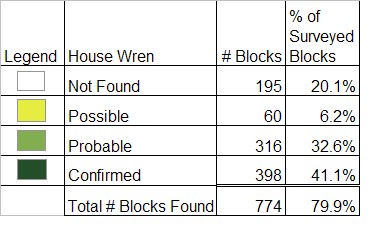Breeding Bird Atlases (BBA)
Find a Bird - BBA1
Breeding Bird Atlas 1 Species Accounts
House Wren
Troglodytes aedon
Egg Dates
May 9 to July 25
Number of Broods
one or two

The cocked tail characteristic of this species is an apt symbol of its cheeky attitude, loud and aggressive behavior, and polygamous mating habits. Indeed, the Chippewa called it “big noise for its size.” Yet the House Wren is less aggressive than the larger (and louder) Carolina Wren and the House Sparrow, which, at the turn of the century, was generally blamed for a marked decrease in the wren population due to competition for available nest sites. After 1917, the House Wren increased from being rare and local to locally common, and by the 1930s it had made a comeback. The species now breeds fairly evenly throughout Massachusetts except on Cape Cod, where its numbers are sparser, and Nantucket, where no evidence of nesting was found during the Atlas period.
House Wrens inhabit suburbs, parks, gardens, farms, orchards, wood edges, and open forests, frequenting low woody vegetation, vine tangles, and brushy areas. They appear in Massachusetts in late April and early May. The average arrival date for territorial males at a site in Ipswich from 1974 to 1985 was May 3 (range April 26 to May 10). Females generally arrive about 10 days later than the males.
A complete account of the courting and nesting behavior of this adaptable species could fill an entire book. Unlike most other birds (except some of the other wrens), male House Wrens, upon establishing their .5- to 3.5-acre territories, immediately set to work building stick nests in every suitable cavity. These may include birdhouses, natural cavities, woodpecker holes, or less orthodox sites including boxes, baskets, clothespin bags, pockets of clothing hanging on a line, old hats, blankets, pumps, radiators, flowerpots, shoes, cans, pipes, skulls, nests of other birds including kingfishers and Ospreys, and even wasp nests. One pair reportedly kept trying to build in the axle of a car in daily use, and another pair filled a two-gallon bucket with sticks. This last behavior, filling the cavity entirely, is typical, and while sticks form the usual base, pieces of metal are also sometimes used. The nest is then built on top of the pile. When a female arrives, the loud, bubbling song of the male becomes higher and squeakier; then, with quivering wings and tail cocked, he tries to lead the prospective mate to his various nests. If she likes one, she may proceed to add lining material; at other times, she will remove all of the sticks and rebuild the entire structure.
Habitats for 48 Massachusetts nests were as follows: wooded area (11 nests), field or field edge (10 nests), suburban (16 nests), old orchard (4 nests), hedgerow (3 nests), marsh edge (1 nest), farm (3 nests) (CNR). Of 51 state nests, 49 were in nest boxes, 1 was under the eaves of a shed, and 1 was in a natural cavity in a Gray Birch stump. The boxes were located from 3.5 to 10 feet in height, with an average of 5.8 feet. One box was placed at 25 feet. The nest under the eaves and the nest in the natural cavity were each at 8 feet in height (CNR).
A typical clutch of six to eight (range three to twelve) eggs is incubated by the female alone for about 13 days, starting after the last egg is laid. Clutch sizes for 36 Massachusetts nests were three eggs (1 nest), four eggs (6 nests), five eggs (6 nests), six eggs (13 nests), seven eggs (9 nests), eight eggs (1 nest) (CNR). At 3 nests in North Brookfield, eggs were laid respectively from May 9 to May 15, May 12 to May 17, and July 6 to July 11 (CNR). Two known state hatch dates were May 27 and July 24 (CNR). The young are fed by both parents and fledge in 12 to 18 days. Nestlings have been reported in the state from May 25 to August 16. Brood sizes for 30 Massachusetts nests were three young (5 nests), four young (8 nests), five young (5 nests), six young (8 nests), seven young (4 nests) (CNR). The fledglings remain with one or both parents for another 12 to 13 days. Both adults and young produce harsh, chattering call notes. The range of dates for fledglings in the Commonwealth is June 7 to August 17. Known state fledge dates are June 12, June 15, June 25, July 2, July 6, August 2 (including a brood of seven from Taunton), and August 16 (CNR). Of 47 state nests, 18 resulted in fledged young, 13 failed, and 16 had an unknown outcome (CNR).
A small percentage of males mate with two females, generally dividing their attention between the two broods. Some females may begin a second brood with a new mate in a different territory before the first young are fledged, leaving the latter in the care of the original male. In at least one case, a pair raised two broods simultaneously, with each bird incubating a separate clutch of eggs. In addition, wrens will sometimes destroy the nests, eggs, or young of their own and other species. Yet, at times, they have been observed feeding the young or the incubating adults of other species when frustrated in their own reproductive attempts.
Following nesting, House Wrens move to deeper woods until departing in September or October and are thus less often encountered at this time. The adults have a complete molt and the young a partial one after the breeding season. By mid-October, most have departed New England. A few stragglers are noted into winter, but it is unlikely that many overwinter successfully. House Wrens winter in the southern United States and Mexico.
Map Legend and Data Summary
Atlas 1 data collected from 1975-1979


Note: common and widespread; uncommon to rare on the Cape and Vineyard
James Berry



